Sunday’s Premier League began with a clash between Wolves and Everton at the Molineux Stadium. Both teams have not won their last two games, Nuno Espírito Santo and Carlo Ancelotti made the tweaks and tried to win this. Eventually, the home side won by 3-0 and continued the hope of joining the European competitions.
In this tactical analysis, we will dissect the tactics of the managers and explaining why Everton failed to create the opportunities.
Lineups
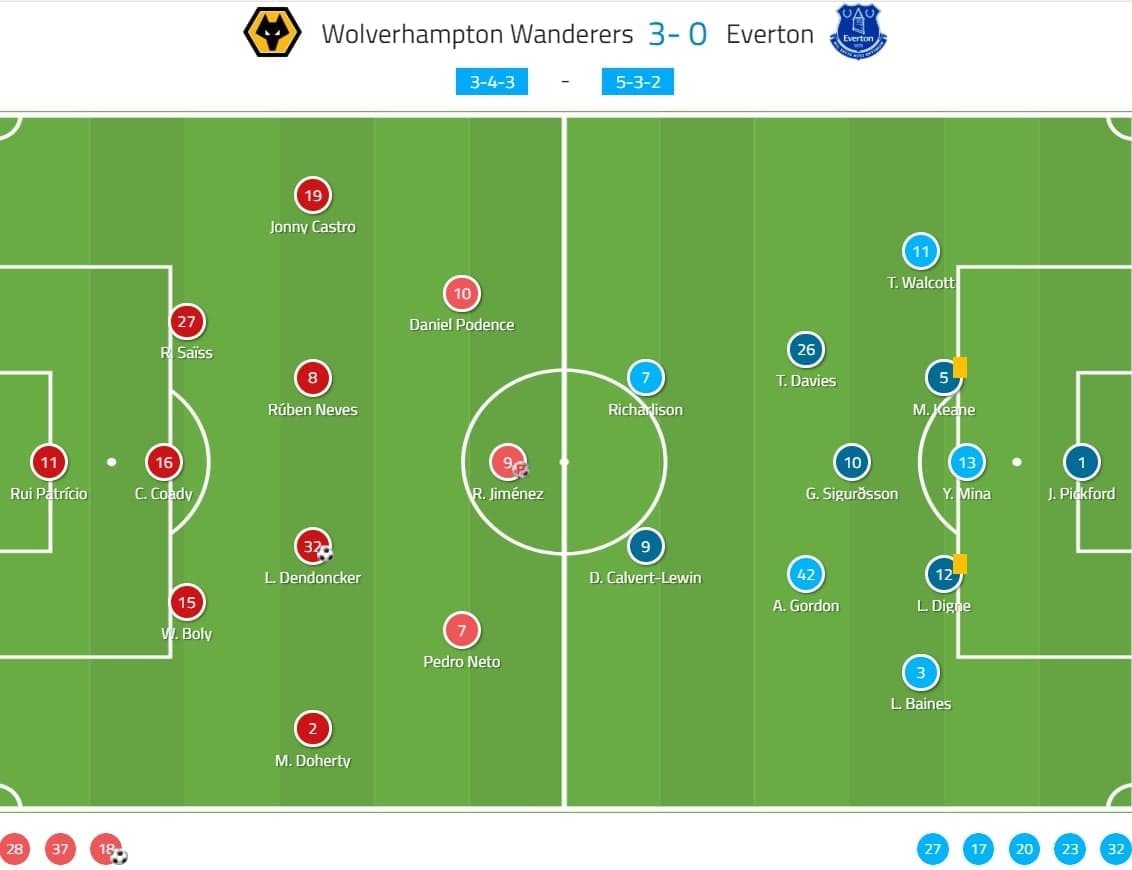
Wolves switched from a 3-5-2 to a 3-4-3 in this game and Nuno rotated the team slightly. Daniel Podence was given his first Premier League start and playing with Pedro Neto together. João Moutinho was rested as Leander Dendoncker and Rúben Neves were the midfield duo.
Everton’s formation was a 5-3-2, with Theo Walcott and Leighton Baines playing as the wing-backs. Lucas Digne was the left centre-back while Gylfi Sigurðsson was the defensive midfielder.
Wolves’ stubborn midblock
Regardless of the opponent Wolves were facing, Nuno was not changing the defensive principles and the defensive setups of were similar. However, with only two players at the midfield meant the additional layer was not provided. Therefore, the wingers should be aware of the positioning the shut the half-spaces and Podence did a great job on it.
In general, the shape was still a 5-5, formed by the back five and a pentagon in front of them. This pentagon was set centrally so to force the ball wide, with the wingers staying narrowly at the half-spaces. Both teams have two central midfielders and the man-orientated markings were possible if needed. Although Anthony Gordon tended to drop at the half-spaces to provide an extra option, Podence was often alert to shut the passing lane. The Toffees could not start and develop an attack on the ground.
As an example, the situation was shown here as Podence covered the passing lane to Gordon. Meanwhile, the markings at the midfield was a 2 v 2 situation. Wing-backs (Jonny Otto) would go for the wing-back (Walcott). Keane had to reorganize the attack by circulating the ball.
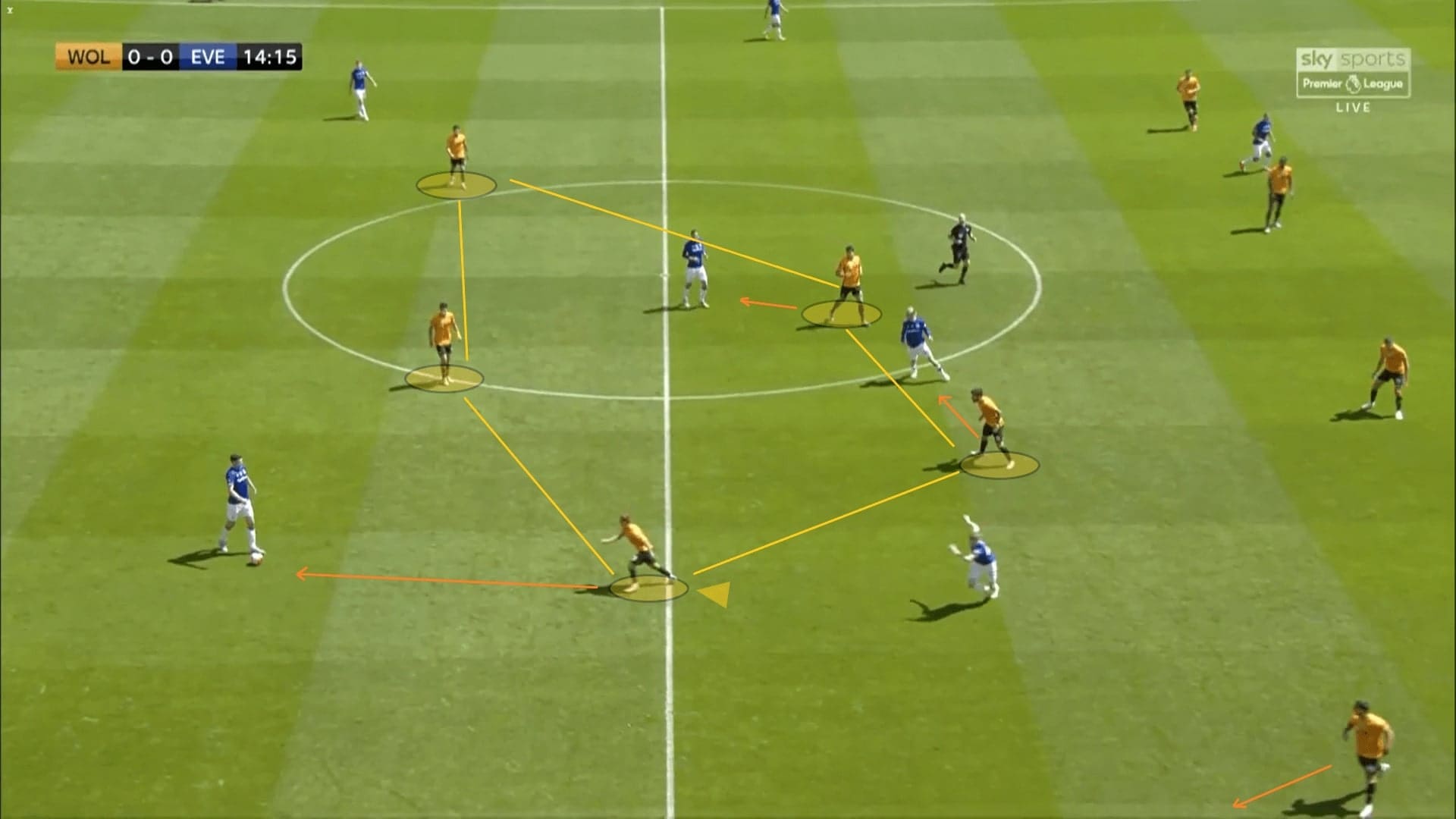
If Everton were brave to pass into the block, Wolves capitalized on the compactness and squeezed spaces or even intercepting the ball. As an example, Sigurðsson tried passing to Tom Davies below but given to the close proximity of players, Neves intercepted it.
Note Podence and Neto’s positions. Although the Wolves #10 dropped deeper to keep an accessible distance to Gordon, it was unnecessary for Neto to follow and maintain a flat shape. Instead, for the offensive transition considerations, another player should stay on Raúl Jiménez’s line. When the Wolves recovered possession, a counter-attack was possible given two options were available.
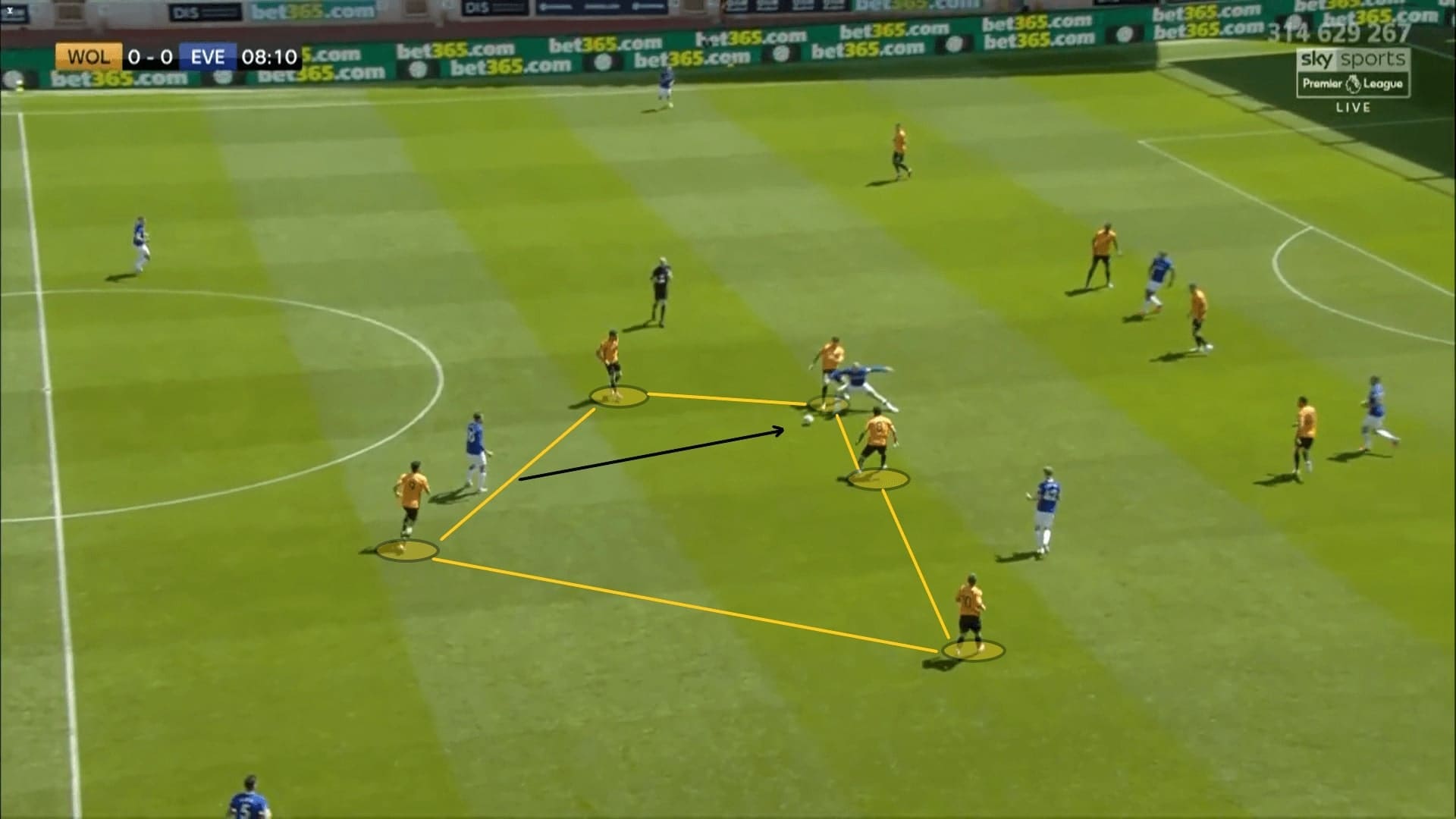
Another method to play into the box was the chipped pass. But, this also fell into the trap of Wolves as the receiver would face the pressure from multiple angles.
Here, Keane lofted the ball to Gordon, which bypassed the block. However, things were uneasy as the youngster was receiving the ball with closed body shape. Wolves were pressing with three players – the midfield duo and Conor Coady, from three angles and hardly could the attack develop under the instant pressure.
We have shown how Wolves were defending the flanks in our previous analysis. This was not the case today as Everton could not even progress to that stage.
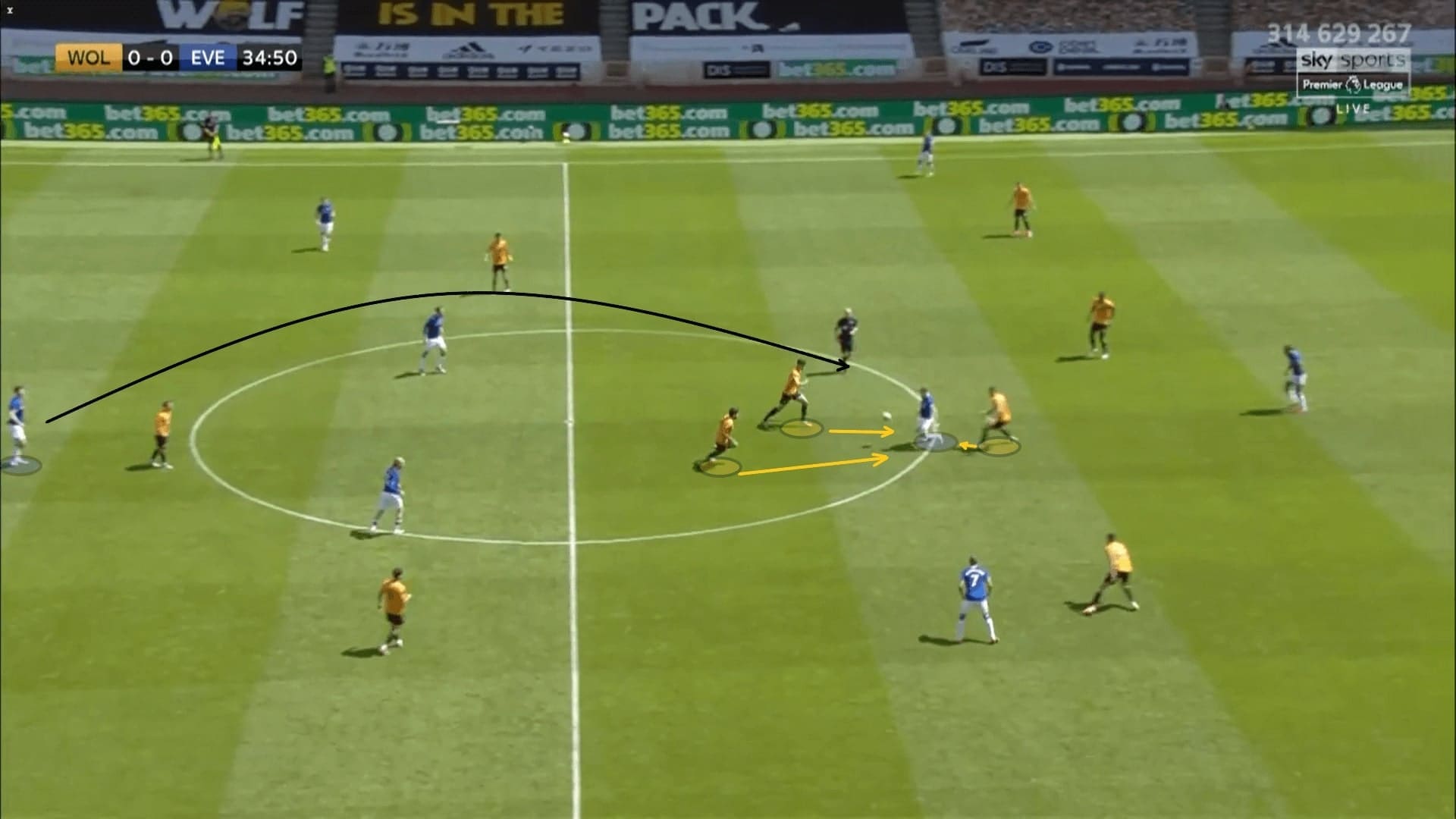
Build-up inefficacy
Despite the change of formation and playing as a back three, the build-up issues of Everton remained unsolved and this was a major factor of struggling to create the chances.
The offensive structure of Everton was a bit like 3-2-3-2 or a 3-4-1-2, not too important because of the flexible positionings of players. As the wing-backs, Walcott and Baines were tasked to provide the width and tried stretching the defensive shape.
However, the underload at the centre made Everton difficult to develop the attack through the pivots. The duo was often covered by the Wolves players or man-marked by the opposition midfielders. Below was a case which Sigurðsson and Davies were under the shadow opposition first line.
Consequently, the wide centre-backs were the free players to play the out-ball. To cope with the block and offer a central option, Gordon would drop to the half-spaces but he was unlikely to be free because of the Wolves players around, mostly Neves. Below is an example. When dropping, the body orientations of Gordon were closed and hindered further progression.
If passing to the wing-back, such as Walcott, he lacked option even the body orientation was okay. Under the instant pressure of Jonny and Matt Doherty, hardly could the wing-backs develop plays with ground passes because lacking options. Finding the strikers by direct through passes was a method, but the success rate was unsatisfactory.
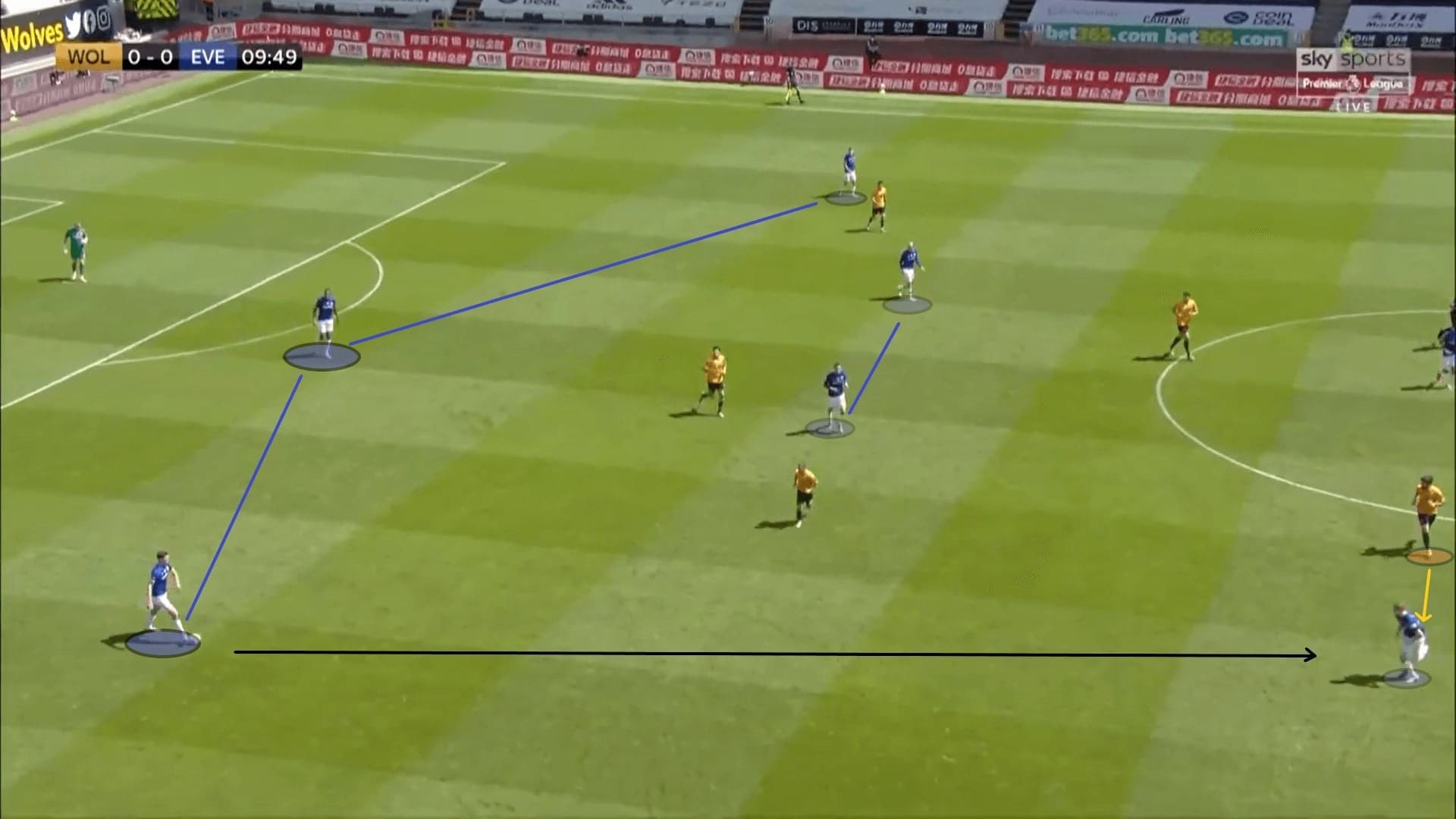
Sometimes Gordon could escape the pressure with the skills in the transitions. This was the opportunity for Everton to develop the attack as the carrier would be facing the backline. The below case is an example as Gordon dribbled past Neves and continued drifting forward.
However, this was still suboptimal when considering only using two strikers to stretch a three-man defence was not enough. On the far side, Baines was never connected in the attack and the only options were Richarlison and Dominic Calvert-Lewin. Both players were running forward but Wolves were never outnumbered – contained by Wily Boly and Romain Saïss in this case.
From the Wolves’ perspective, Saïss did a good job here. His initial horizontal movement before pressuring Gordon was a good tactic to delay the carrier while covering Calvert-Lewin. When carrying the ball forward, Gordon lacked the flair and skills to escape the challenges and he had to pass the ball away without promising options available.
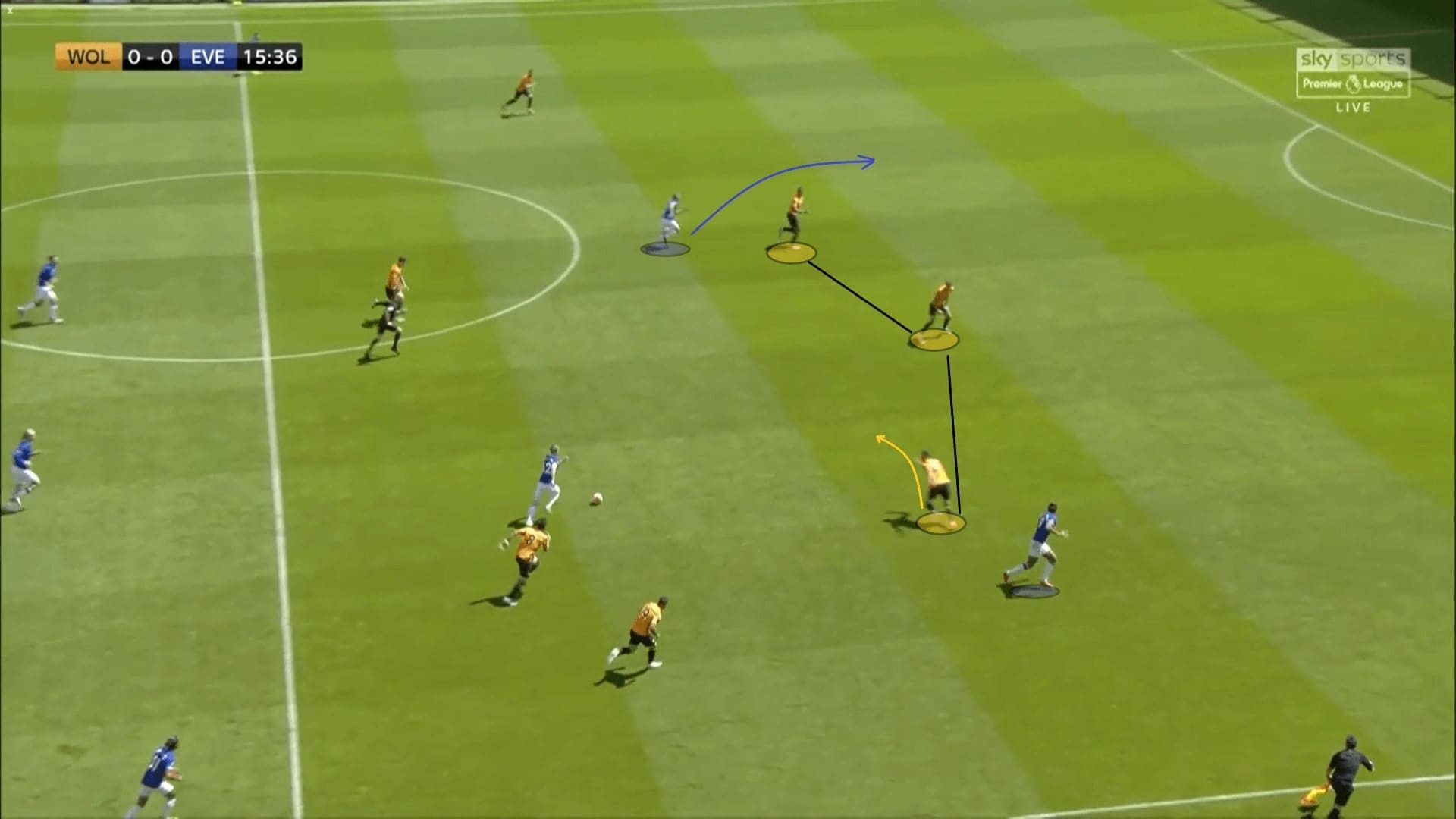
Another domain we would like to address was the conservativeness of the Everton midfielders. As the pivots and an attacking player, we should expect Sigurðsson to dictate plays from deep and progress the ball to the advanced areas or key players. The passing and decisions of the Iceland international was not aggressive enough and this hindered the development of the attacks as well.
Below is the top passing links graph of Sigurðsson. Note the players who are connected with him, they were Keane, Yerry Mina, Digne, Davies, Walcott and Séamus Coleman – none of them is the progressive options. This pattern has suggested Sigurðsson was unable to transfer the ball forward.
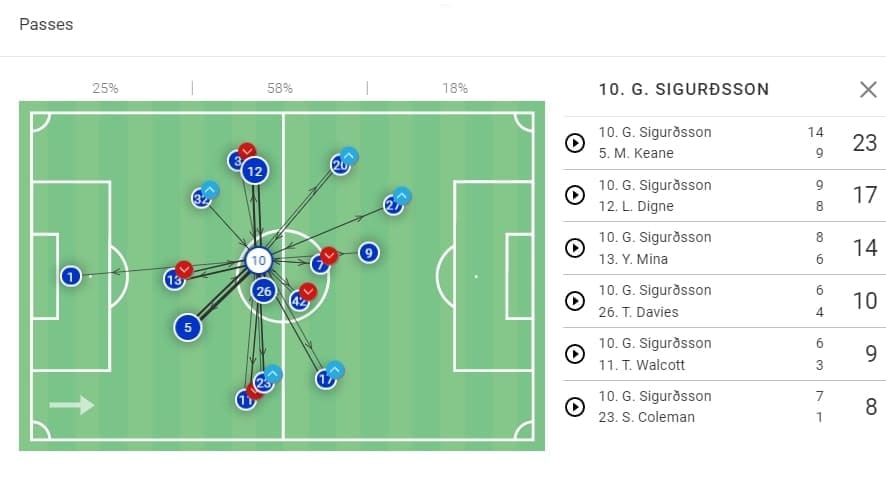
We extracted this in-game example to illustrate the conservativeness of Everton pivots. Not the 2 v 2 or two separated 1 v 1 situations at the far side. It should be a situation that the Toffees hoping to exploit but they did not do anything about it.
Again, Gordon dropped as a progressive option for Keane, finding the third man – Davies who had a better angle of vision and passing-range now. However, the Everton #26 did not try playing the ball to that zone, but passing to his partner: Sigurðsson safely. This was okay as the passes were played with the first touch, the opponents were still yet to react.
However, even the ball was moved to Sigurðsson’s feet, a better passer than Davies, his decision to find Digne was disappointing. Why don’t try hitting the left flank when given this opportunity to exploit the numerical equality? Playing a safe pass could avoid losing the ball but this does not offer progression. This was a typical example of Everton’s attack in the first half. Basically, there were no strategies to enter the final third, excepting the direct long passes.
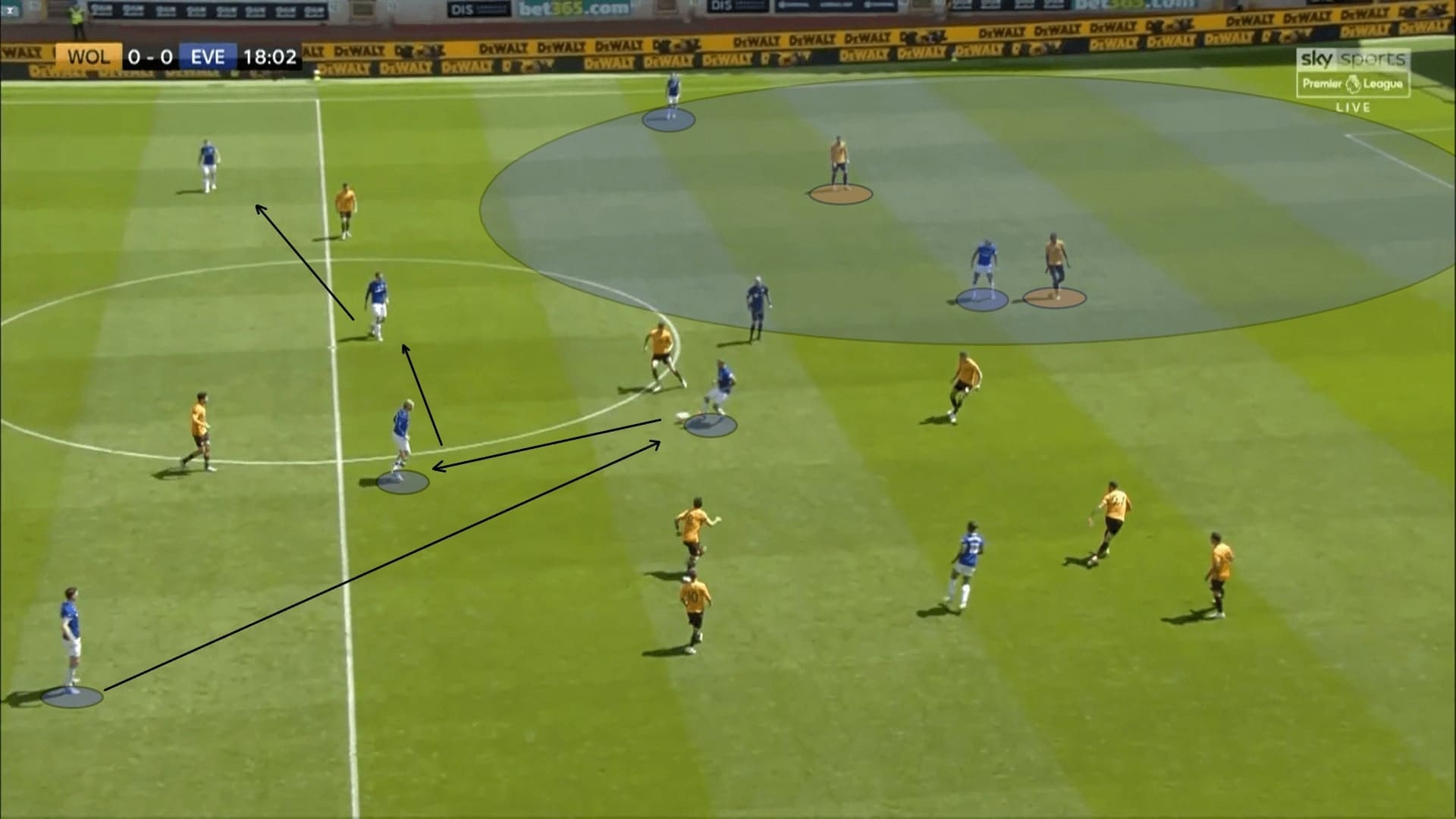
Everton defensive style of play
From a defensive standpoint, this 5-3-2 shape did help the Toffees to structure a better defence. Again, the team was not pressing high but tended to form a midblock at the centre. An underload of 2 v 3 at Wolves’ backline was inevitable. This was compensated by a numerical superiority at the centre, where Everton had three midfielders against the Wolves duo.
The wing-backs matched the wing-backs perfectly. Below, Baines came high to approach Doherty. This 3-2 block was the general shape of Ancelotti’s men as shown below.
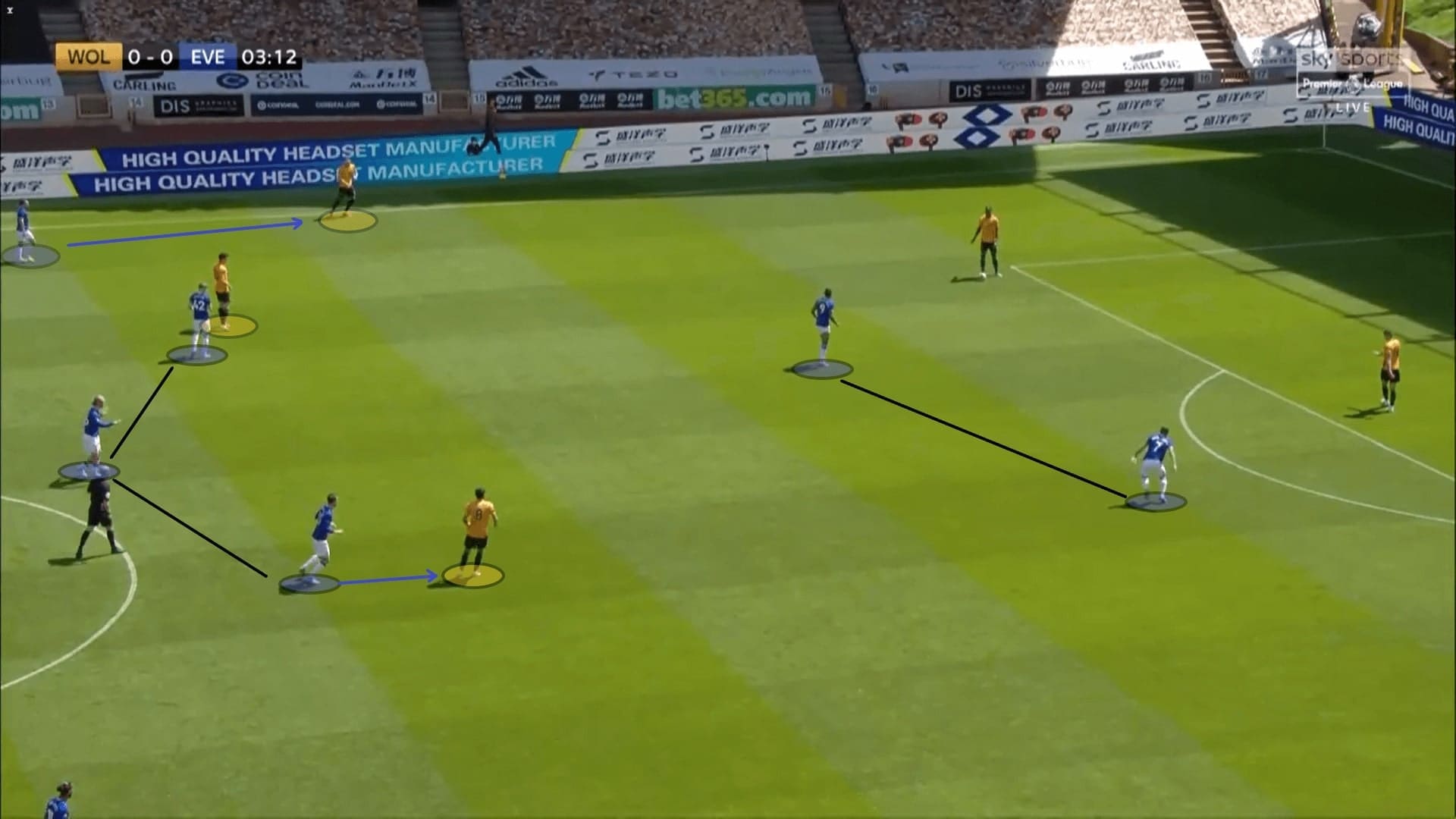
When defending deep, the 5-3-2 or a 5-3-1-1 shape was more observable as we demonstrated here. Notice the deep positioning and close proximity of the two lines, this shape was difficult to break because of the numbers committed in it. Wolves could merely rely on the flair and skills of the attacking players, such as Podence and Neto to take on multiple players and generate the shooting opportunities.
In this example, a slight flaw would be the defensive ability of Walcott, who was more natural at the winger position. This certainly made the game easier for Podence on the left.
However, the deep block also constrained the transition phase of Everton once regaining the ball. Ideally, Calvert-Lewin and Richarlison were available at the front, but the Toffees could not pass directly to the target man. Sometimes Richarlison would come deeper but as you see, Wolves were not pushing every man forward in the attack. The Brazilian would be trapped and pressured by more than one player, seldom have the time to wait for the support.
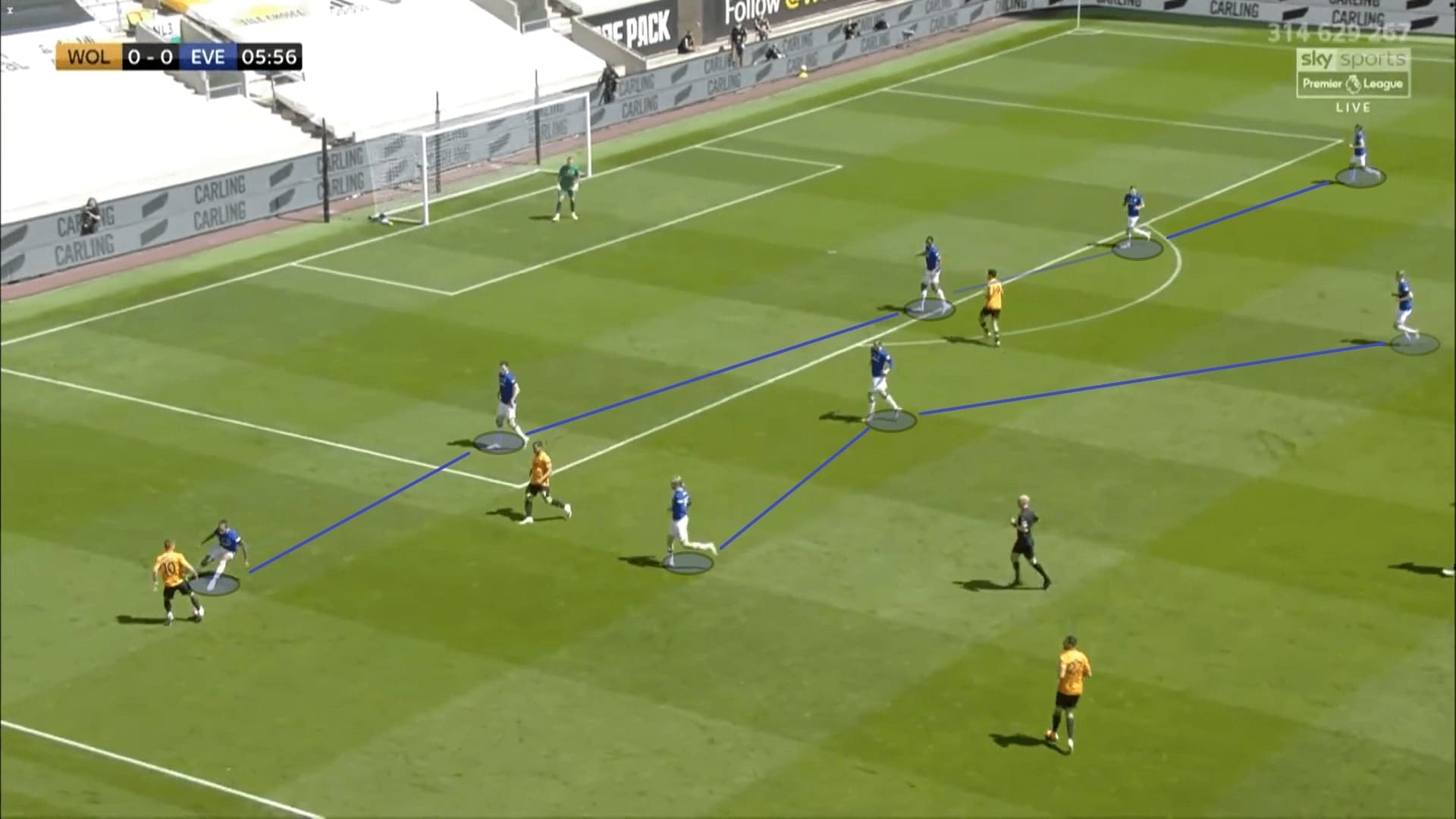
An advantage of this shape would be the flexibility to deal with the wide attacks of Wolves. The opponents often develop the attack at flanks by a triangle and some rotations. The 5-3-2 shape allowed Everton to commit more men, roughly four to five to protect that zone.
For example, Wolves were attacking from the right and the 3 v 3 numerical equality was achieved. What Sigurðsson and Keane were doing was to track the runners in case the blindsides of the ball-side players were exploited. This should be easily done given the body orientations when facing the flank would allow keeping the opponents in sight.
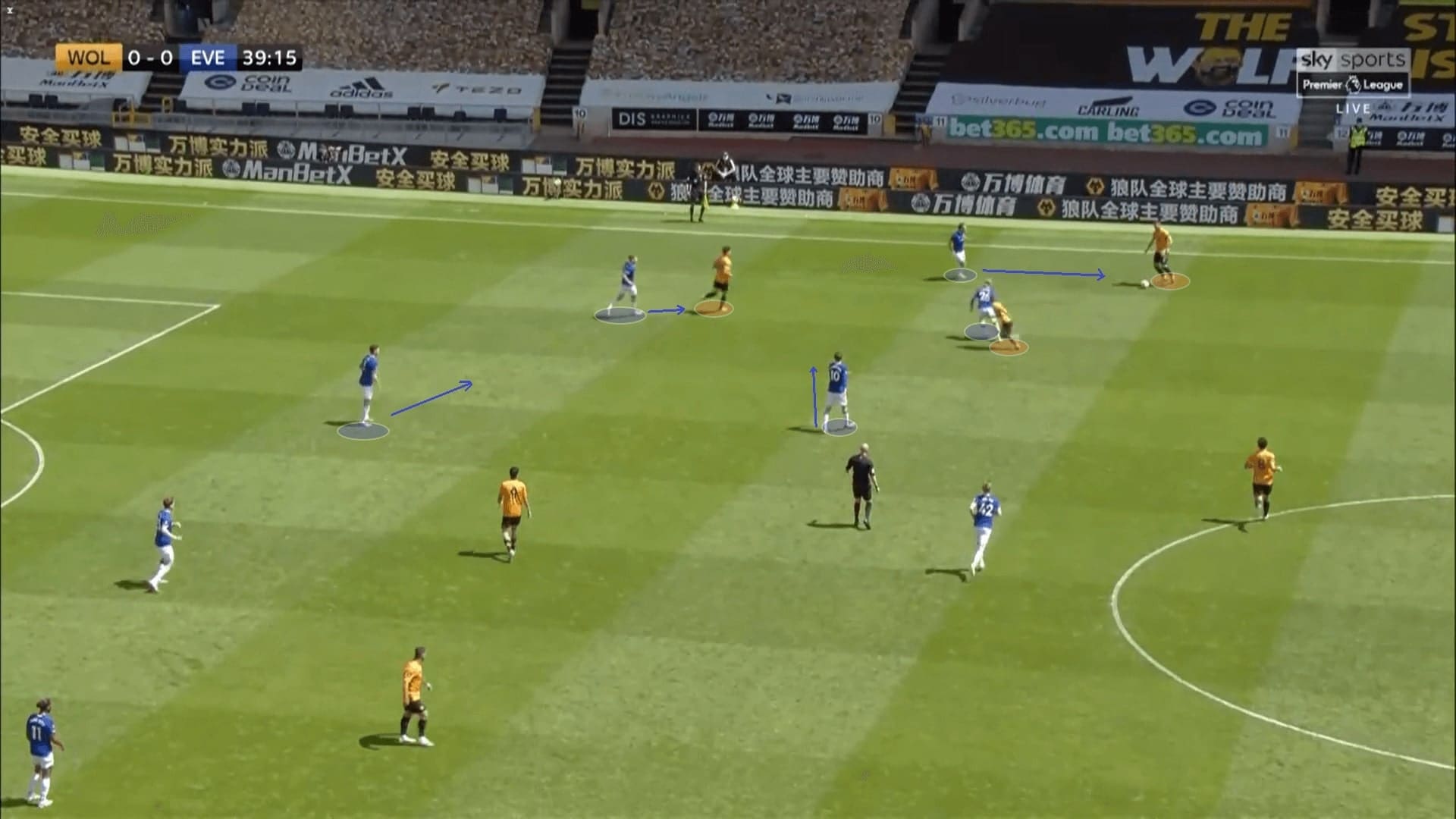
Switching to a 4-2-2-2
After Podence won a penalty and Jiménez’s converted the spot-kick, Everton were a goal down again and they needed a goal. As explained, Ancelotti’s tactics in the first half failed to develop meaningful chances as Everton were struggling to enter the offensive third.
By replacing Baines, Walcott and Gordon with Alex Iwobi, Bernard and Jarrad Branthwaite, the shape was switched to a 4-2-2-2 and Everton were attacking differently.
In the first half, the first and second layer was not connecting well while the wing-backs failed to make the impacts. Moving Digne and Coleman as the full-backs allowed these two to move the ball forward. At the wide areas, Digne could carry the ball forward and have greater autonomy than playing as a wide centre-back. The former Barcelona man progressed to the central third below.
Now, the third layer was formed by the wingers, which means there were two players. Comparing to Gordon alone, Iwobi and Bernard’s inward movements and exploitation of the half-spaces allowed Everton to control the opposition second line better. Also, tucking between players often set the wingers being free from tight marking.
In this example, Digne combined with Bernard, who was unmarked because of Iwobi’s behaviour to manipulate the Wolves midfielders. Everton entered the offensive third.
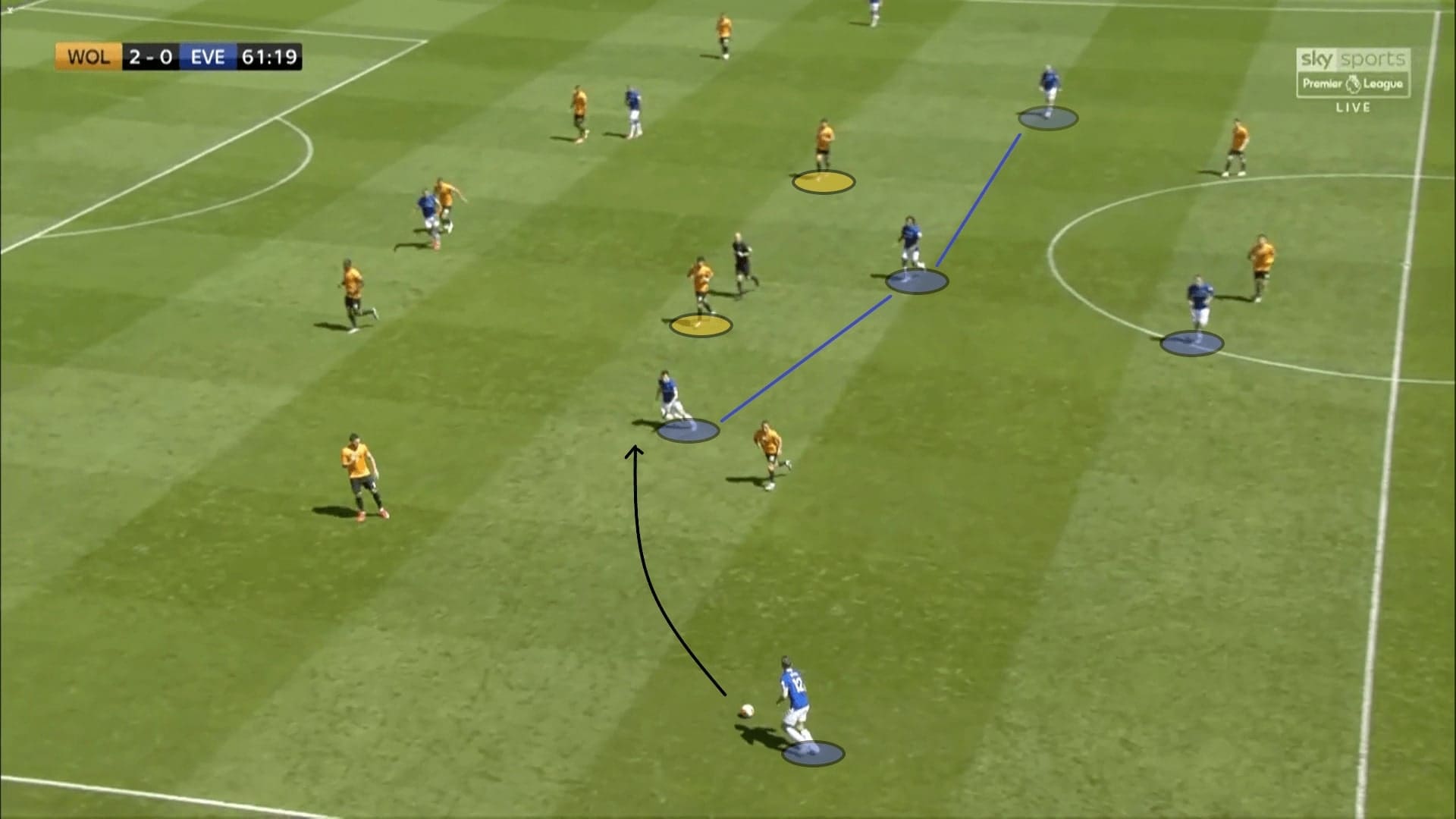
Another function of the inverted wingers was to release the full-backs. When Bernard or Iwobi was making the inward movements, the wing-backs would follow and the outer zone was opened for the overlapping full-back.
In this example, Bernard came inside while taking Doherty with him. On the far side, Digne dashed forward and received the pass from Iwobi. Another benefit to playing the Nigerian winger instead of Walcott here was the ability and dynamics to operate centrally and pass.
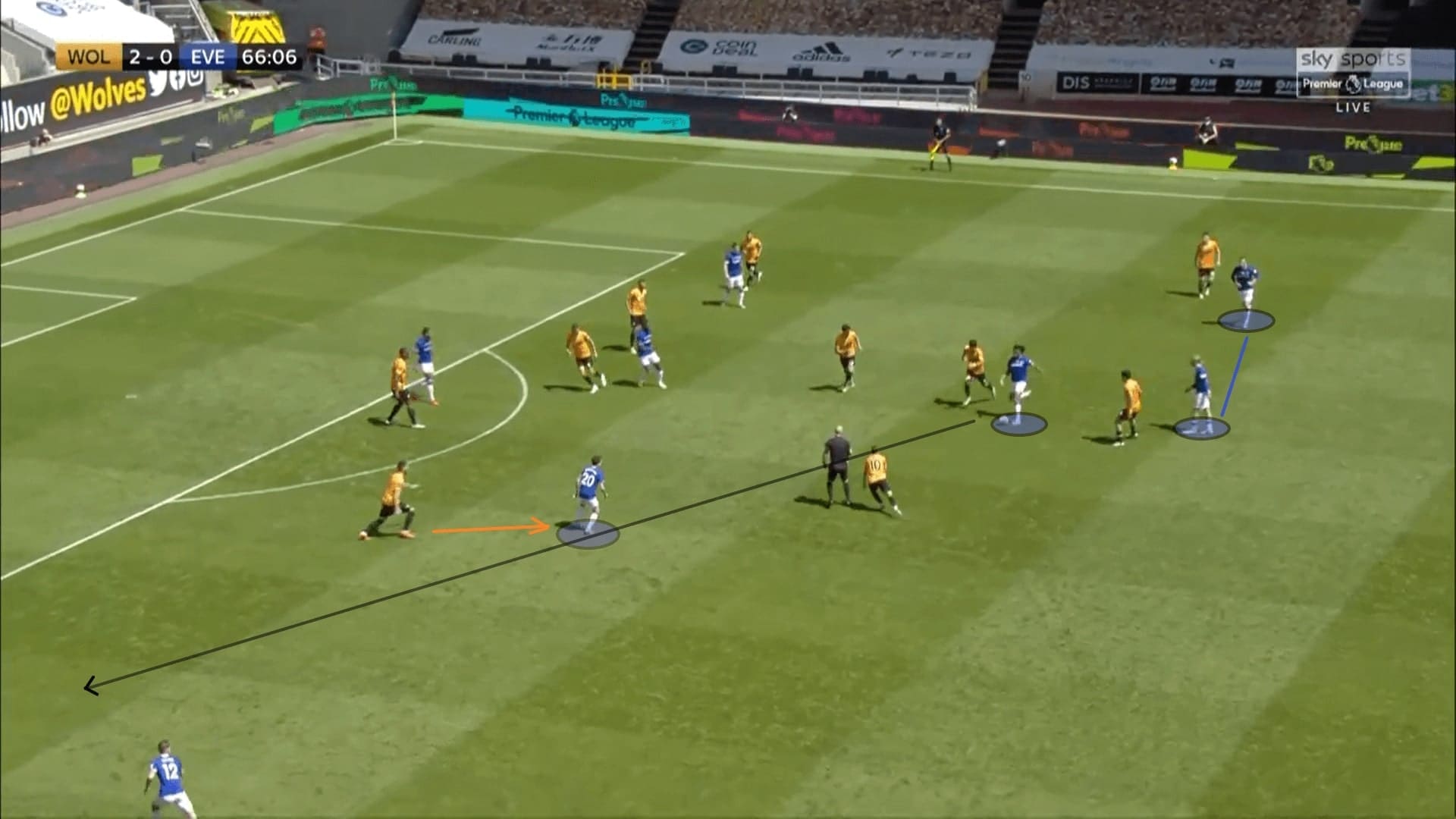
However, the build-up inefficacy was not totally solved. The reason is twofold, not only because of the solid and well-structured midblock from Wolves, but also the passive involvement of the central midfielders.
For example, Sigurðsson and Davies formed the second line but none of them was available because of opponents’ shadowing efforts. Same from Iwobi and Bernard. Lacking options and facing the pressure, Coleman could only try a long ball for Richarlison. Perhaps more movements in these two lines could improve the interconnectedness of players and strengthen the build-up.
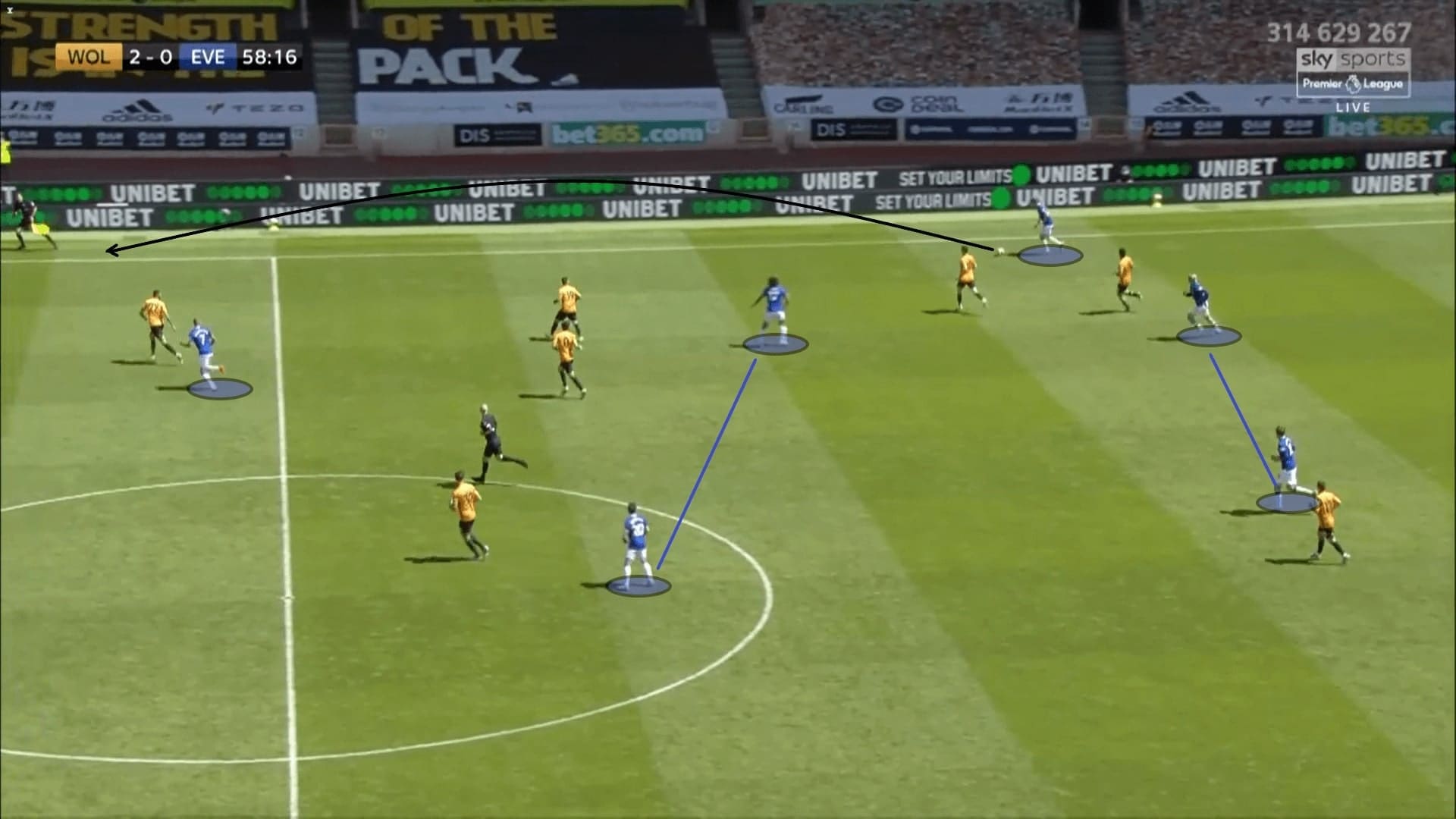
While switching to a 4-2-2-2, this shape was less solid when comparing to a back five. Everton failed to contain the likes of Podence and Neto during the defensive phase. The Wolves wingers were clever to position themselves between players, where a positional superiority was maximized and no marker was near.
In this scene, Podence was between Branthwaite, Digne and Bernard, being the free player and a progressive option. The defence was often stretched by the wing-backs, leaving spaces behind the full-backs and Wolves were smart to exploit.
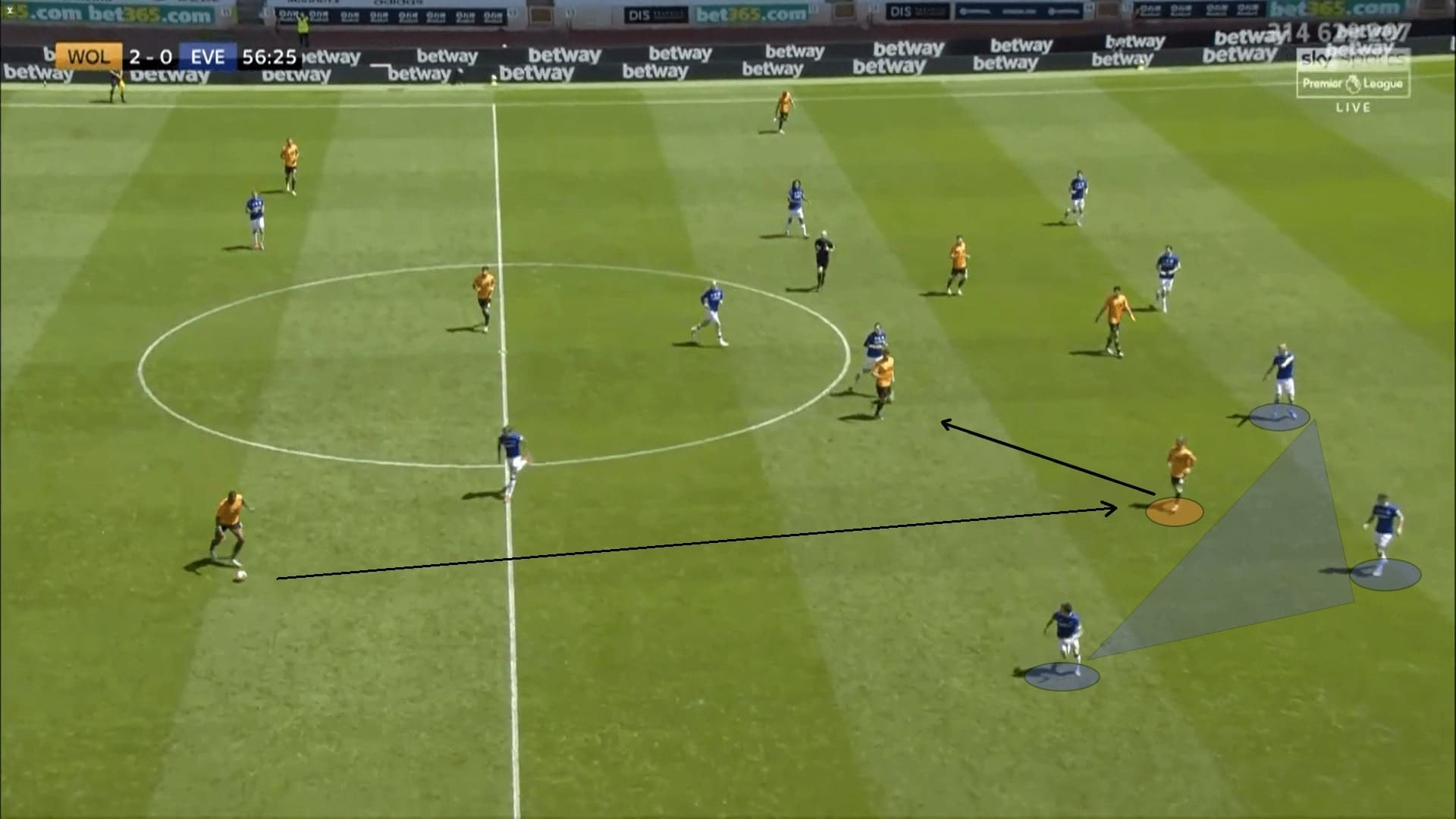
Final remarks
It was an important victory for Wolves after the last two defeats. Despite making minor tweaks in the personnel used, Nuno’s men still take all three points at home soil, keeping a one-point margin with Sheffield.
Everton had a bad day, lost the game while Mina suffered an injury. It was impossible to achieve the Europa League qualification for next season already, the remaining three games would be a good chance for Ancelotti to experiment and examine his squad.




Comments